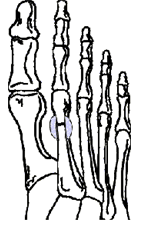 Metatarsal Stress Fracture
Metatarsal Stress Fracture
 A
stress fracture is a break in a bone cause
by repetitive stress. It may occur in any bone, but is quite
common in the metatarsal bones of the foot. There is often
no recollection of injury. A
stress fracture is a break in a bone cause
by repetitive stress. It may occur in any bone, but is quite
common in the metatarsal bones of the foot. There is often
no recollection of injury.
The patient may simply develop a painful forefoot after some
activity, such a running, sports, or stooping down onto the
ball of the foot. A small crack develops in the cortex (outer
shell) of the bone.
Without proper treatment, this may progress to a "through
and through" (overt) fracture of the bone. The second
and third metatarsals are the most commonly affected. Metatarsal
stress fracture may not become apparent on x-rays
until a few weeks after the injury.
Symptoms
- Sharp pain in the forefoot, aggravated by walking
- Tenderness to pressure on the top surface of a metatarsal
bone.
- Diffuse swelling of the skin over the forefoot.
Causes
- Decreased density of the bones (ie osteoporosis)
- Unusual stress on a metatarsal due to faulty foot mechanics
or another forefoot deformity (eg. bunion)
- Abnormal foot structure or mechanics (ie flat feet)
- Increased levels of activity, especially without proper
preparation (ie runners suddenly increasing mileage and
training intensity)
- Obesity
What you can do
- Seek professional help as soon as possible
- Keep weight off the foot
- Ice the top surface of the forefoot for about 20 minuets
every hour the (ice pack should never be placed directly
on the skin)
- To reduce swelling, wrap the foot in a compressive bandage
with moderate compression (always consult a pharmacist regarding
the correct size and type of bandage)
- Wear a shoe with a very stiff sole.
- Use a prefabricated pronation control orthotic such as the Orthosport Activ-8 ™ orthotic, a perfect choice for moderate over pronators.
What the Podiatrist may do
- Order bone scan or x-rays to confirm the fracture. X-rays
do not show stress fractures until 14 days after the event
- Apply orthopaedic taping and padding to relieve stress
from the metatarsals
- Splint the foot.
- Recommend medication for pain and inflammation.
- Use physical therapy in the later stages of healing.
- Occasionally a plaster cast is necessary
- If you have had previous stress fractures a detailed
analysis of your running style will be undertaken to
pinpoint
any biomechanical problems
Other causes of forefoot pain
- Morton's neuroma (benign tumour of a nerve running between
the metatarsals)
- Metatarsalgia (painful and inflammation of the metatarsal
bones and their soft tissue sheath)
- Capsulitis (painful and inflammation of the joints between
the metatarsal bones and toes)
- Tendonitis (inflammation of the tendons which course along
the top of the foot)
· Dislocation of a joint between a metatarsal and
a toe (metatarsal-phalangeal joint)
- Severe plantar callus(callus on bottom of the foot) or
bursitis(an inflamed fluid-filled sack often between a bone
and an area of pressure).
|
...............................
 top
of page
top
of page
 ............................
............................ |

